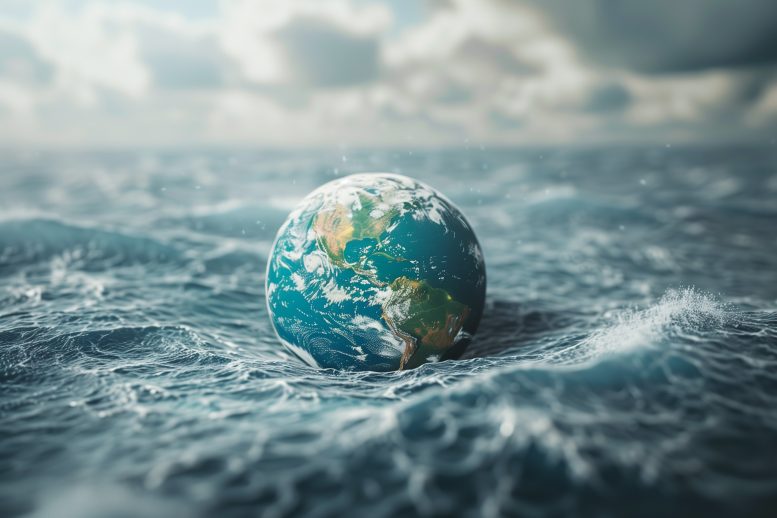
Oxygen is crucial for life on Earth, but the ocean’s ability to absorb it is diminishing due to global warming, affecting marine ecosystems and human activities. Research involving chemical and morphological analyses of microscopic fossils found in marine sediments has shown that during past climate change events, like the PETM, the tropical ocean’s oxygen levels increased, which may have mitigated mass extinctions in upper ocean layers, contrary to expectations of widespread oxygen depletion. Credit: SciTechDaily.com
Enhanced oxygen levels in the tropical ocean during an abrupt global warming event in geological history
Oxygen is essential for maintaining life on Earth. The ocean receives its oxygen from the top layers that are in contact with the atmosphere. However, as the Earth warms, the ocean’s ability to hold oxygen is slowly diminishing, leading to significant impacts on marine ecosystems and the human activities reliant on them. Although it is expected that these trends will persist, the future distribution of oxygen within the ocean’s interior remains uncertain. This is because ocean currents and the biological breakdown of biomass have a greater influence than atmospheric diffusion in these regions.
“Marine sediments are the history book of the ocean. By studying past intervals of time in which temperatures increased rapidly, we can gain precious insights on how ocean oxygen and biology responded to changes in climate,” said Simone Moretti who is the lead author of a now published in the research journal Science.
Using a combination of chemical and morphological measurements on foraminifera, microscopic fossils preserved in marine sediments over millions of years, a team of researchers led by scientists at the Max Planck Institute for Chemistry in collaboration with Princeton University has reconstructed the response of tropical ocean oxygenation during the PETM.
Nitrogen isotopes and fossil size reveal the oxygen content of seawater
Nitrogen isotopes preserved within fossil foraminifera enabled the scientists to track past changes in column denitrification in the water. This process, in which nitrate is converted to molecular nitrogen (N2) by bacteria, only occurs within the most oxygen-depleted waters of the ocean: the oxygen-deficient zones. “Our measurements showed that, contrary to most expectations, denitrification decreased during the PETM, implying that the oxygen-deficient zones of the ocean contracted during this interval of abrupt global warming,” said Alfredo Martínez-García, head of the laboratory at MPIC where the study was conducted.
In addition, the size of foraminifera fossils proved to be a fundamental piece of the puzzle. Models that describe the metabolism of marine organisms allow to link their body size to the environmental temperature and oxygen content of the water they live in. A reduction in body size is an effective adaptation to a warming climate, as it allows organisms to reduce their metabolism in times of stress.
“Remarkably, and unexpectedly, evidence shows that planktonic foraminifera from the central tropical Pacific got bigger during the PETM warming, implying a tropical oxygen rise in the upper layers of the ocean,” commented Curtis Deutsch, Professor of Geosciences at the University of Princeton, who co-authored this study. Planktonic foraminifera live in the upper layers of the ocean, in contrast to those found on the bottom.
Oxygen increase could have mitigated mass extinction in the upper ocean
The finding that oxygen levels in the tropical ocean increased rather than decreased during the PETM warming also provides the researchers with a clue to another puzzle, that of changes in marine biodiversity. The PETM was the largest extinction event among deep ocean organisms within the Cenozoic Era, spanning the past 66 million years. One of many mysteries linked to the PETM is that while this large extinction event unfolded at greater depths, organisms living in the uppermost part of the ocean were less affected.
“The transient tropical oxygenation revealed by our study may have contributed to preserving habitability despite a large temperature stress,” said Simone Moretti. “However, during the PETM the fauna in the surface ocean was nonetheless heavily impacted, and it took more than one hundred thousand years for these ecosystems to recover towards their original state, an eternity in human-civilization timescales.”
Reference: “Oxygen rise in the tropical upper ocean during the Paleocene-Eocene Thermal Maximum” by Simone Moretti, Alexandra Auderset, Curtis Deutsch, Ronja Schmitz, Lukas Gerber, Ellen Thomas, Valeria Luciani, Maria Rose Petrizzo, Ralf Schiebel, Aradhna Tripati, Philip Sexton, Richard Norris, Roberta D’Onofrio, James Zachos, Daniel M. Sigman, Gerald H. Haug and Alfredo Martínez-García, 15 February 2024, Science.
DOI: 10.1126/science.adh4893









An important question that neither got asked or answered is WHY the oxygen level increased when they imply that such would be a violation of Henry’s Law. Might it be that the warmth stimulated growth of vegetation on land and photosynthetic plankton, increasing the atmospheric oxygen concentration, and the resulting increase in the oxygen partial-pressure kept the dissolved oxygen elevated?
A related question is why did the ocean deeps experience a loss of oxygen when the water was probably cold, and if circulation was similar to today, oxygen could have been been brought in at the poles.
A working hypothesis to consider is that with enhanced biological activity at the surface, dying plankton would have created an increased demand for oxygen through the bacterial decomposition of the plankton ‘snow’ falling through the water. That is, too much of a good thing.
Warming isn’t always bad.
“A reduction in body size is an effective adaptation to a warming climate, as it allows organisms to reduce their metabolism in times of stress.”
The unstated assumption is that the warmth was actually stressful. David Attenborough has publicly stated that the Tropics account for 1% of the land area, yet 50% of the known species of life are found there. That doesn’t sound too stressful for terrestrial life.